Energy Consumption in Mexican Homes: Using a Reference Building as a Launchpad for Achieving Nearly Zero Energy
Abstract
:1. Introduction
2. Methods
2.1. Studied Cities and Climate
2.2. Reference Building (RB)
2.3. Energy
2.3.1. Fixed Energy Consumption
Lighting
Appliances
Cooking
2.3.2. Variable Energy Consumption
Domestic Hot Water (DHW)
Heating and Cooling
2.4. Comparison with Available Data
3. Results
3.1. Configuration of the Reference Building
3.1.1. Building
3.1.2. Materials
3.1.3. Occupancy
3.2. Energy Use
3.2.1. Fixed Energy Consumption
3.2.2. Variable Energy Consumption
DHW
Heating
Cooling
3.2.3. Total Energy Use
3.3. Comparison
3.3.1. Electricity
3.3.2. Gas
4. Discussion
5. Conclusions
- Update building codes by incorporating energy efficiency requirements and minimums on renewable energy use into national building codes, such as establishing limits on primary energy consumption and promoting using materials that enhance thermal performance.
- Develop professional training programs for architects, engineers, and builders in techniques and technologies. Create skills certification systems to ensure compliance with standards.
- Launch educational campaigns to inform the public about the benefits of better-performing buildings in terms of energy efficiency, economic savings, and environmental impact.
- Conscious implementation of subsidies or low-interest financing for projects that adopt nZEB standards, motivating developers and owners to invest in sustainable technologies.
- Intensify actions to promote research and development by funding research projects that seek innovations in design, materials, and technologies for nZEB buildings adapted to local cultural and climatic conditions.
Supplementary Materials
Author Contributions
Funding
Data Availability Statement
Acknowledgments
Conflicts of Interest
Abbreviations
| CONAVI | National Housing Commission |
| DHW | Domestic hot water |
| ENCEVI | National Survey on Energy Consumption in Homes |
| ENEA | Italian National Agency for New Technologies, Energy, and Sustainable Economic Development |
| ENUT | National Time Use Survey |
| ENVI | National Housing Survey |
| EPBD | Energy Performance of Buildings Directive |
| GHG | Greenhouse gases |
| HVAC | Heating, ventilation, and air conditioning |
| IEA | International Agency for Energy |
| LPG | LP gas |
| nZEB | nearly zero energy buildings |
| PROFECO | Federal Consumer Protection Bureau |
| PRONACE | National Strategic Program |
| RB | Reference building |
| RUV | Housing Registry |
| SDG | Sustainable Development Goals |
| SECIHTI | Science Secretary |
| UN | United Nations |
Appendix A
| Characteristics | Description, Value | Reference |
|---|---|---|
| Building | - | |
| Type | Residential mixed building | - |
| Size | Construction area: 19.2 m × 19.2 m, height: 14 m | - |
| Number of floors | 5 floors (1 commercial use, 4 residential) | - |
| Envelope surface area | Total: 1843.2 m2, walls and roof: 1474.5 m2 | - |
| Volume | 5308.41 m3 | - |
| Surface-area-to-volume ratio | Total: 0.35, walls and roof: 0.27 | - |
| Infiltration rate | 1.5 air changes per hour (ach) | [56] |
| Dwellings | ||
| Envelope surface area | Total: 1624.3 m2, walls and roof: 1255.7 m2 | - |
| Volume | 4257.8 m3 | - |
| Surface-area-to-volume ratio | Total: 0.38, walls and roof: 0.29 | - |
| Window-to-wall ratio | 11.72% | - |
| Mean occupancy | 3.5 | [52,53] |
| Internal gains | ||
| Occupancy | Domestic activities: 75 W per inhabitant (convective: 31.5 W, radiative: 43.5 W) Resting: 70 W per inhabitant (convective: 28 W, radiative: 42 W) | [57] |
| Appliances | Convective: 3.4 W/m2, radiative: 2.2 W/m2 | [57] |
| Lighting | Convective: 3.4 W/m2, radiative: 5.4 W/m2 | [58] |
| Energy Systems | ||
| Cooling | Minisplit ON/OFF, SEER = 11.5 | [44] |
| Heating | Minisplit ON/OFF, COP = 3 | [44] |
| Water heater | Storage 38 L, n = 0.76 | [43] |
| Lighting | Compact fluorescent lamp | [26] |
| Stove (burner) | thermal capacity = 5126 kJ/h, n = 0.76 | [59] |
| Mechanical ventilation | Without mechanical ventilation | - |
References
- Intergovernmental Panel on Climate Change. Intergovernmental Panel on Climate Change; IPCC Press Release: Geneva, Switzerland, 2021. [Google Scholar]
- United Nations Environment Programme. Global Alliance for Buildings and Construction 2023. In Global Status Report for Buildings and Construction; United Nations Environment Programme: Nairobi, Kenya, 2024. [Google Scholar] [CrossRef]
- United Nations Environment Programme. Global Alliance for Buildings and Construction 2020. In Global Status Report for Buildings and Construction: Towards a Zero-Emissions, Efficient and Resilient Buildings and Construction Sector; United Nations Environment Programme: Nairobi, Kenya, 2020. [Google Scholar]
- Comisión Económica para América Latina y el Caribe. La Agenda 2030 y Los Objetivos de Desarrollo Sostenible: Una Oportunidad Para América Latina y El Caribe; Comisión Económica para América Latina y el Caribe: Santiago, Chile, 2018. [Google Scholar]
- United Nations Department of Economic and Social. Affairs Sustainable Development 11 Make Cities and Human Settlements Inclusive, Safe, Resilient and Sustainable. Available online: https://sdgs.un.org/goals/goal11#targets_and_indicators (accessed on 28 January 2025).
- INEGI; INFONAVIT; SHF. Encuesta Nacional de Vivienda (ENVI), 2020. 2021. Available online: https://www.inegi.org.mx/programas/envi/2020/ (accessed on 1 April 2025).
- Registro Único de Vivienda Información Estratégica/Cifras Básicas RUV. Available online: http://portal.ruv.org.mx/index.php/cifras-basicas-ruv/ (accessed on 15 January 2025).
- Espino-Reyes, C.A.; Rodríguez-Muñoz, N.A. Perspectiva de Programas y Políticas de Eficiencia Energética En Los Edificios Residenciales En México. In Proceedings of the XLVI Semana Nacional de Energía Solar, Hermosillo, Mexico, 3–7 October 2022. [Google Scholar]
- Tori, F.; Bustamante, W.; Vera, S. Analysis of Net Zero Energy Buildings Public Policies at the Residential Building Sector: A Comparison between Chile and Selected Countries. Energy Policy 2022, 161, 112707. [Google Scholar] [CrossRef]
- Secretaría de Desarrollo Agrario Territorial y Urbano. Programa Nacional de Vivienda 2019–2024; Sociedad Hipotecaria Federal: Anzures, Miguel Hidalgo, 2019. [Google Scholar]
- Science Council SECIHTI. Programas Nacionales Estratégicos PRONACES: Vivienda. Available online: https://secihti.mx/pronaces/pronaces-vivienda/ (accessed on 28 January 2025).
- United Nations Human Settlements Programme (UN-Habitat). World Cities Report 2020 the Value of Sustainable Urbanization; United Nations Human Settlements Programme (UN-HABITAT)-Headquarters: New York, NY, USA, 2020. [Google Scholar]
- ONU-Habitat; INFONAVIT. Vivienda y ODS En México. 2018. Available online: https://onu-habitat.org/index.php/la-vivienda-en-el-centro-de-los-ods-en-mexico (accessed on 1 April 2025).
- 4S Real State Foresight Gran Reporte de Verticalización 2024. 2024. Available online: https://publicacionesonuhabitat.org/onuhabitatmexico/VIVIENDA_Y_ODS.pdf (accessed on 1 February 2025).
- Laboratorio Nacional de Políticas Públicas; Citibanamex; Centro de Investigación y Docencia Económicas; Centro Mario Molina. Instituto Mexicano para la Competitividad Índice de Ciudades Sostenibles-Resultados. Available online: https://ics.lnpp.mx/#resultados (accessed on 23 January 2023).
- Córdova, F.; Alpuche, M. Relación Entre La Intensidad de Uso de Energía y La Morfología Urbana Densificación Como Estrategia de Mitigación Del Cambio Climático. Vivienda Comunidades Sustentables 2022, 12, 27–54. [Google Scholar] [CrossRef]
- Lopez-Ordoñez, C.; Garcia-Nevado, E.; Crespo-Cabillo, I.; Roset Calzada, J.; Coch, H. Reducing Residential Cooling Demand in a Sprawling Desert City through Vertical Urban Densification. J. Build. Eng. 2024, 95, 110089. [Google Scholar] [CrossRef]
- Sarkar, A.; Jana, A. Interpreting the Energy Choices and Environmental Satisfaction Determinants in Low-Income Housing Typologies: Cases from Slums and Slum Rehabilitation Housing of Mumbai, India. Cities 2023, 143, 104576. [Google Scholar] [CrossRef]
- Del Hierro López, I.; Polo, J.; Martín Chivelet, N.; Olivieri, F.; Caamaño-Martín, E.; Olivieri, L. Photovoltaic Self-Sufficiency Potential at a District Scale in Madrid. A Scalable Methodology. Energy Build. 2024, 323, 114764. [Google Scholar] [CrossRef]
- Li, W.; Zhou, Z.; Han, Y. An Actual-Performance-Oriented Study on the Relationship between Environmental Efficiency and Passive Design Factors for Multi-Family Dwellings in Cold Areas. Energy Build. 2023, 285, 112825. [Google Scholar] [CrossRef]
- Alonso, C.; Oteiza, I.; Martín-Consuegra, F.; Frutos, B. Methodological Proposal for Monitoring Energy Refurbishment. Indoor Environmental Quality in Two Case Studies of Social Housing in Madrid, Spain. Energy Build. 2017, 155, 492–502. [Google Scholar] [CrossRef]
- Vallati, A.V.; Fiorini, C.; Grignaffini, S.; Ocłoń, P.; Di Matteo, M.; Kobylarczyk, J. Energy Retrofit Optimization for Social Building in Temperate Climate Zone. Energy Build. 2023, 282, 112771. [Google Scholar] [CrossRef]
- Vallati, A.; Di Matteo, M.; Sundararajan, M.; Muzi, F.; Fiorini, C.V. Development and Optimization of an Energy Saving Strategy for Social Housing Applications by Water Source-Heat Pump Integrating Photovoltaic-Thermal Panels. Energy 2024, 301, 131531. [Google Scholar] [CrossRef]
- Hernandez-Cruz, P.; Giraldo-Soto, C.; Escudero-Revilla, C.; Hidalgo-Betanzos, J.M.; Flores-Abascal, I. Energy Efficiency and Energy Performance Gap in Centralized Social Housing Buildings of the Basque Country. Energy Build. 2023, 298, 113534. [Google Scholar] [CrossRef]
- European Environmental Agency. European Union Directive 2010/31/EU of the European Parliament and of the Council of 19 May 2010 on the Energy Performance of Buildings (Recast); European Environmental Agency: Copenhagen, Denmark, 2010. [Google Scholar]
- INEGI; CONUEE; SENER. Encuesta Nacional Sobre Consumo de Energéticos En Viviendas Particulares (ENCEVI) 2018. 2018. Available online: https://www.inegi.org.mx/programas/encevi/2018/ (accessed on 1 February 2025).
- INEGI; INMUJERES. Encuesta Nacional Sobre El Uso Del Tiempo (ENUT). 2019. Available online: https://www.inegi.org.mx/programas/enut/2019/ (accessed on 1 February 2025).
- SEDATU; CONAVI. Código de Edificación de Vivienda, 3rd ed.; International Finance Corporation: Washington, DC, USA, 2017; Available online: https://www.gob.mx/cms/uploads/attachment/file/383811/C_digo_de_Eficaci_n_Vivienda_2017__SEDATU.pdf (accessed on 1 February 2025).
- Procuraduría Federal del Consumidor. Estudios de Calidad. Available online: https://www.gob.mx/profeco/es/articulos/estudio-de-calidad (accessed on 29 January 2025).
- Ahern, C. Introducing the Default Effect: Reducing the Gap between Theoretical Prediction and Actual Energy Consumed by Dwellings through Characterising Data More Representative of National Dwellings Stocks; Technological University Dublin: Dublin, Ireland, 2019. [Google Scholar]
- Zhang, X.; Wang, A.; Tian, Z.; Li, Y.; Zhu, S.; Shi, X.; Jin, X.; Zhou, X.; Wei, S. Methodology for Developing Economically Efficient Strategies for Net Zero Energy Buildings: A Case Study of a Prototype Building in the Yangtze River Delta, China. J. Clean. Prod. 2021, 320, 128849. [Google Scholar] [CrossRef]
- ANSI/ASHRAE 55-2023; Thermal Environmental Conditions for Human Occupancy. American National Standards Institute–ANSI: New York, NY, USA, 2023.
- DIAL. GmbH About DIALux. Available online: https://www.dialux.com/en-GB/about-dial (accessed on 28 January 2025).
- Calidad y Sustentabilidad en la Edificación, A.C. Código de Conservación de Energía Para Las Edificaciones de México (IECC-MÉXICO); Reaktion Books: London, UK, 2016; Volume 1, ISBN 978-1-60983-662-7. [Google Scholar]
- DiLaura, D.L.; Houser, K.W.; Mistrick, R.G.; Steffy, G.R. The Lighting Handbook: Reference and Application, 10th ed.; Illuminating Engineering Society: New York, NY, USA, 2011; ISBN 9780879952419. [Google Scholar]
- PELL ENEA LENICALC. Available online: https://www.pell.enea.it/pell_building (accessed on 28 January 2025).
- Secretaría de Energía. Norma Oficial Mexicana NOM-005-ENER-2016 Eficiencia Energética de Lavadoras de Ropa Electrodomésticas. Límites, Métodos de Prueba y Etiquetado; Diario Oficial de la Federación DOF: Ciudad de México, México, 2016.
- Secretaría de Energía. Norma Oficial Mexicana NOM-015-ENER-2018 Eficiencia Energética de Refrigeradores y Congeladores Electrodomésticos. Límites, Métodos de Prueba y Etiquetado; Diario Oficial de la Federación DOF: Ciudad de México, México, 2018.
- Desroches, L.-B.; Fuchs, H.; Greenblatt, J.B.; Pratt, S.; Willem, H.; Claybaugh, E.; Beraki, B.; Nagaraju, M.; Price, S.K.; Young, S.J. Computer Usage and National Energy Consumption: Results from a Field-Metering Study. 2015. Available online: https://escholarship.org/uc/item/5k12d7q0#main (accessed on 1 February 2025).
- Horowitz, N.; Hardy, G.; Swofford, J.; Walters, P.; Driscoll, D.; Dayem, K.; Small Network Equipment Energy in U.S. Homes Less Energy to Connect Electronic Devices. 2013. Available online: https://www.nrdc.org/sites/default/files/residential-network-IP.pdf (accessed on 1 February 2025).
- PROFECO. Revista del Consumidor; Procuraduría Federal del Consumidor: Ciudad de México, México, 2011. [Google Scholar]
- García-Valladares, O.; Ituna-Yudonago, J.F. Energy, Economic and Emissions Avoided Contribution of Domestic Solar Water Heating Systems for Mexico, Costa Rica and the Democratic Republic of the Congo. Sustain. Energy Technol. Assess. 2020, 39, 100721. [Google Scholar] [CrossRef]
- Secretaría de Energía. Norma Oficial Mexicana NOM-003-ENER-2011 Eficiencia Térmica de Calentadores de Agua Para Uso Doméstico Comercial. Límites, Métodos de Prueba y Etiquetado; Diario Oficial de la Federación DOF: Ciudad de México, México, 2021.
- Secretaría de Energía. Norma Oficial Mexicana NOM-023-ENER-2018 Eficiencia Energética En Acondicionadores de Aire Tipo Dividido, Descarga Libre y Sin Conductos de Aire. Límites, Métodos de Prueba y Etiquetado; Diario Oficial de la Federación DOF: Ciudad de México, México, 2018.
- Argüello Méndez, T.; Argüelles León, B.; Badillo González, M. Características Físicas de La Vivienda Popular En La Periferia Urbana de Tuxtla Gutiérrez; Chiapas, México. Quehacer Científico Chiapas 2012, 4, 4–13. [Google Scholar]
- Piña Hernández, E.H. Prototipo de Vivienda Vertical Social Sustentable, Enfoque En Resistencia al Cambio Climático. Revista. INVI 2018, 33, 213–237. [Google Scholar] [CrossRef]
- Díaz, B.; Rodríguez, S. Características de La Vivienda de Interés Básica, Social y Económica Urbana En Puebla-México. e-Gnosis 2005, 3. Available online: https://www.redalyc.org/pdf/730/73000313.pdf (accessed on 1 April 2025).
- Rodriguez-Muñoz, N.A. Evaluation of the Thermal Performance of Construction Systems to Reduce the Energy Consumption in Buildings: A Case Study in a Cold Semi-Arid Climate. Acta. Univ. Multidiscip. Sci. J. 2020, 30, 1–18. [Google Scholar] [CrossRef]
- Pérez, J.B.; Cabanillas, R.E.; Hinojosa, J.F.; Borbón, A.C. Estudio Numérico de La Resistencia Térmica En Muros de Bloques de Concreto Hueco Con Aislamiento Térmico. Inf. Tecnol. 2011, 22, 27–38. [Google Scholar] [CrossRef]
- Integrated Environmental Solutions Limited. Apache-Tables: User Guide; Integrated Environmental Solutions Limited: Glasgow, UK, 2014. [Google Scholar]
- FANOSA; ALENER. Soluciones Que Cumplen Con La NOM-020-ENER-2011; Comisión Nacional para el Uso Eficiente de la Energía: Ciudad de México, México, 2015; Available online: https://www.gob.mx/cms/uploads/attachment/file/84531/2_FANOSA.pdf (accessed on 1 February 2025).
- Oropeza-Perez, I.; Petzold-Rodriguez, A.H. Analysis of the Energy Use in the Mexican Residential Sector by Using Two Approaches Regarding the Behavior of the Occupants. Appl. Sci. 2018, 8, 2136. [Google Scholar] [CrossRef]
- INEGI. Sistemas de Consulta-Banco de Indicadores. 2020. Available online: https://www.inegi.org.mx/app/indicadores/?ind=1003000015&vind=metadato#D1003000015#D1003000019#D1003000011#D6200108938#D1003000015#D1003000015_56#D1003000015_56 (accessed on 29 January 2025).
- SENER; CONUEE. Lista de Combustibles y Sus Poderes Caloríficos 2021 Que Se Considerarán Para Identificar a Los Usuarios Con Un Patrón de Alto Consumo, Así Como Los Factores Para Determinar Las Equivalencias En Términos de Barriles Equivalentes de Petróleo; SENER: Ciudad de México, México, 2021. [Google Scholar]
- CRE. Micrositio de Gas LP. Available online: https://www.cre.gob.mx/glp/informesTrimestrales.html#:~:text=La%20densidad%20promedio%20del%20Gas,de%200.54%20kilogramo%20por%20litro (accessed on 31 May 2023).
- Younes, C.; Shdid, C.A.; Bitsuamlak, G. Air Infiltration through Building Envelopes: A Review. J. Build. Phys. 2012, 35, 267–302. [Google Scholar] [CrossRef]
- American Society of Heating. Refrigerating and Air-Conditioning Engineers 2021 ASHRAE Handbook—Fundamentals; American Society of Heating, Refrigerating and Air-Conditioning Engineers, Inc. (ASHRAE): Atlanta, Goergia, 2021; ISBN 9781947192898. [Google Scholar]
- Yunus, A.; Cengel, A.J.G. Heat and Mass Transfer Fundamentals & Applications, 5th ed; McGraw-Hill: New York, NY, USA, 2015; ISBN 9780073398181. [Google Scholar]
- Secretaría de Energía. Norma Oficial Mexicana NOM-025-ENER-2013 Eficiencia Térmica de Aparatos Domésticos Para Cocción de alimentos Que Usan Gas, L.P. o Gas Natural. Límites, Métodos de Prueba y Etiquetad; Diario Oficial de la Federación DOF: Ciudad de México, México, 2013.
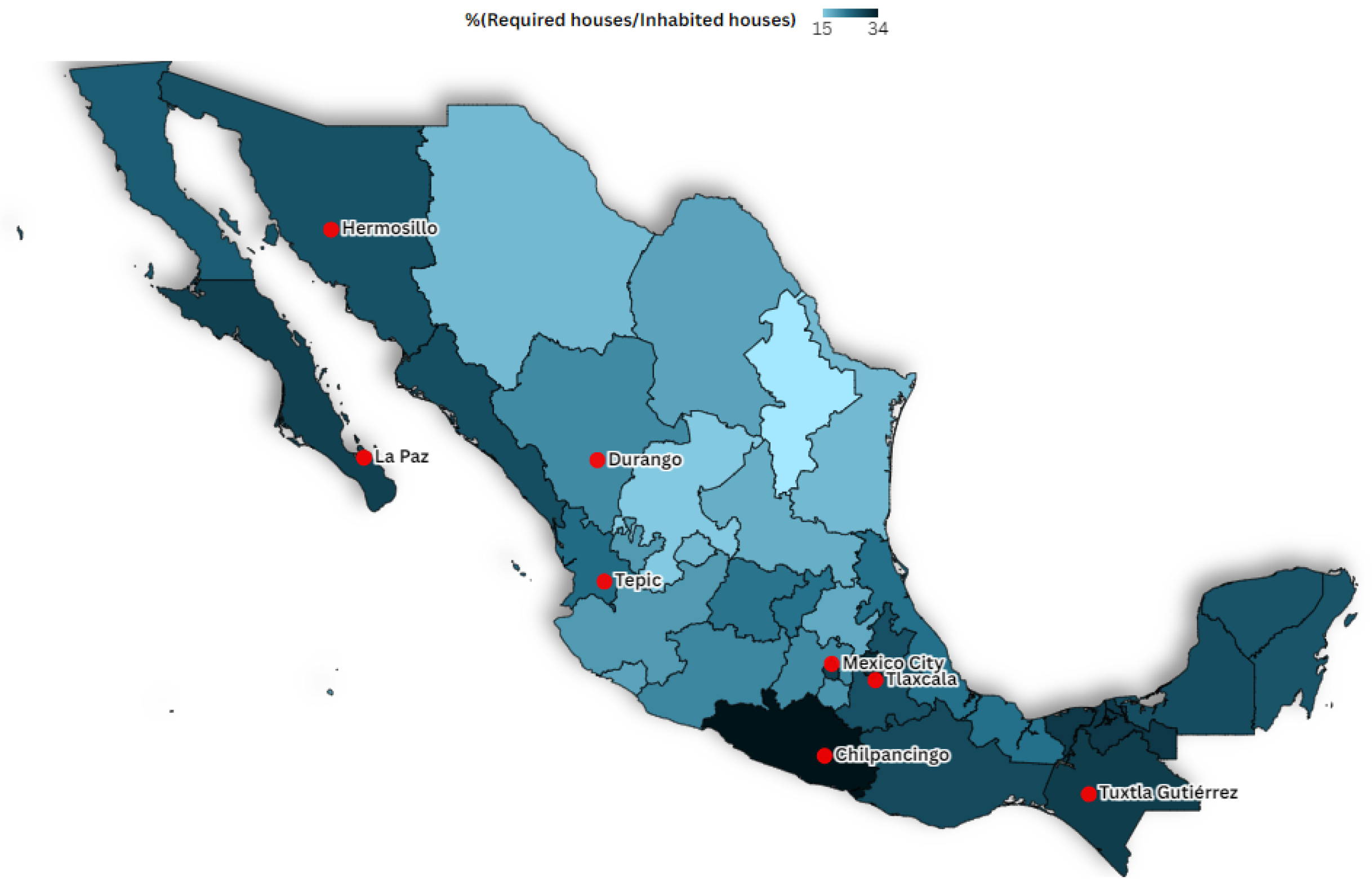
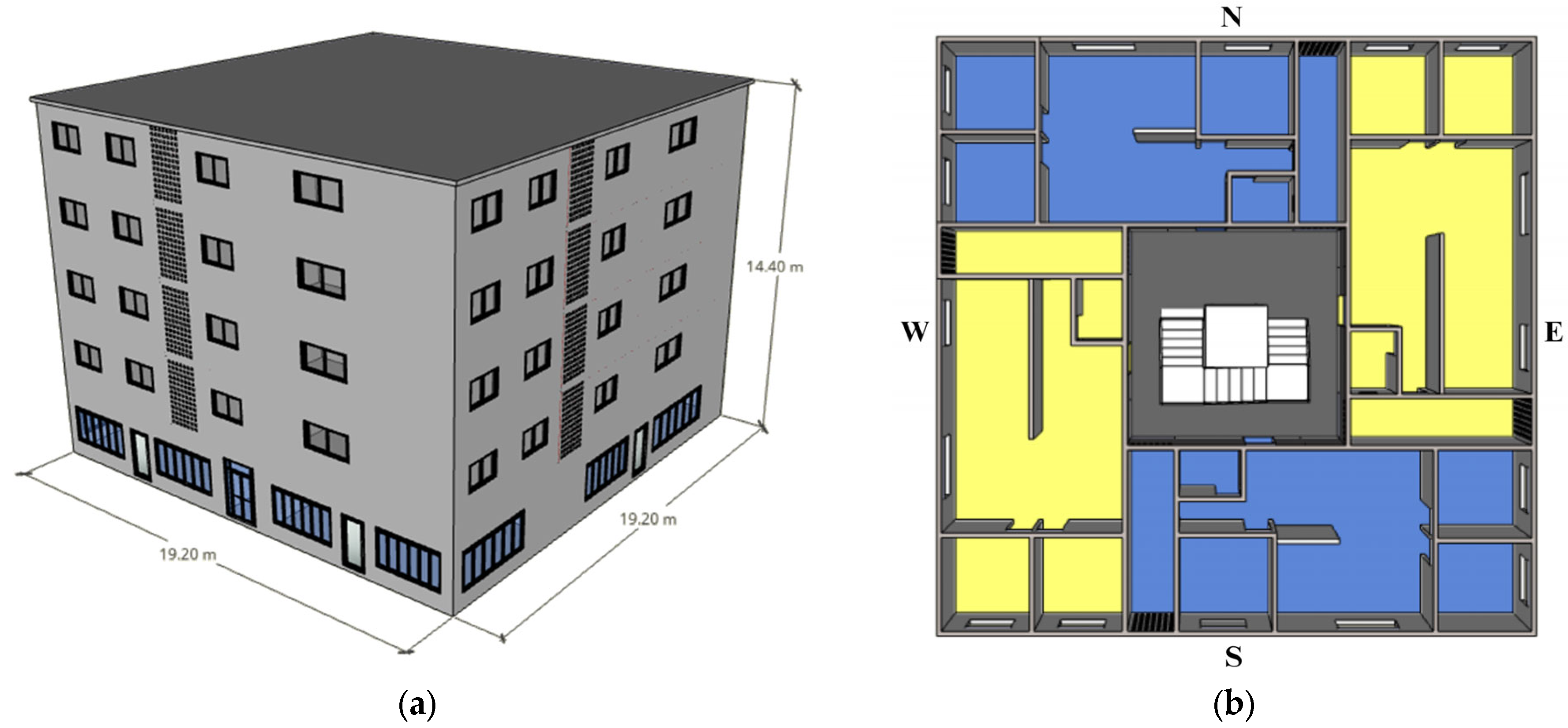

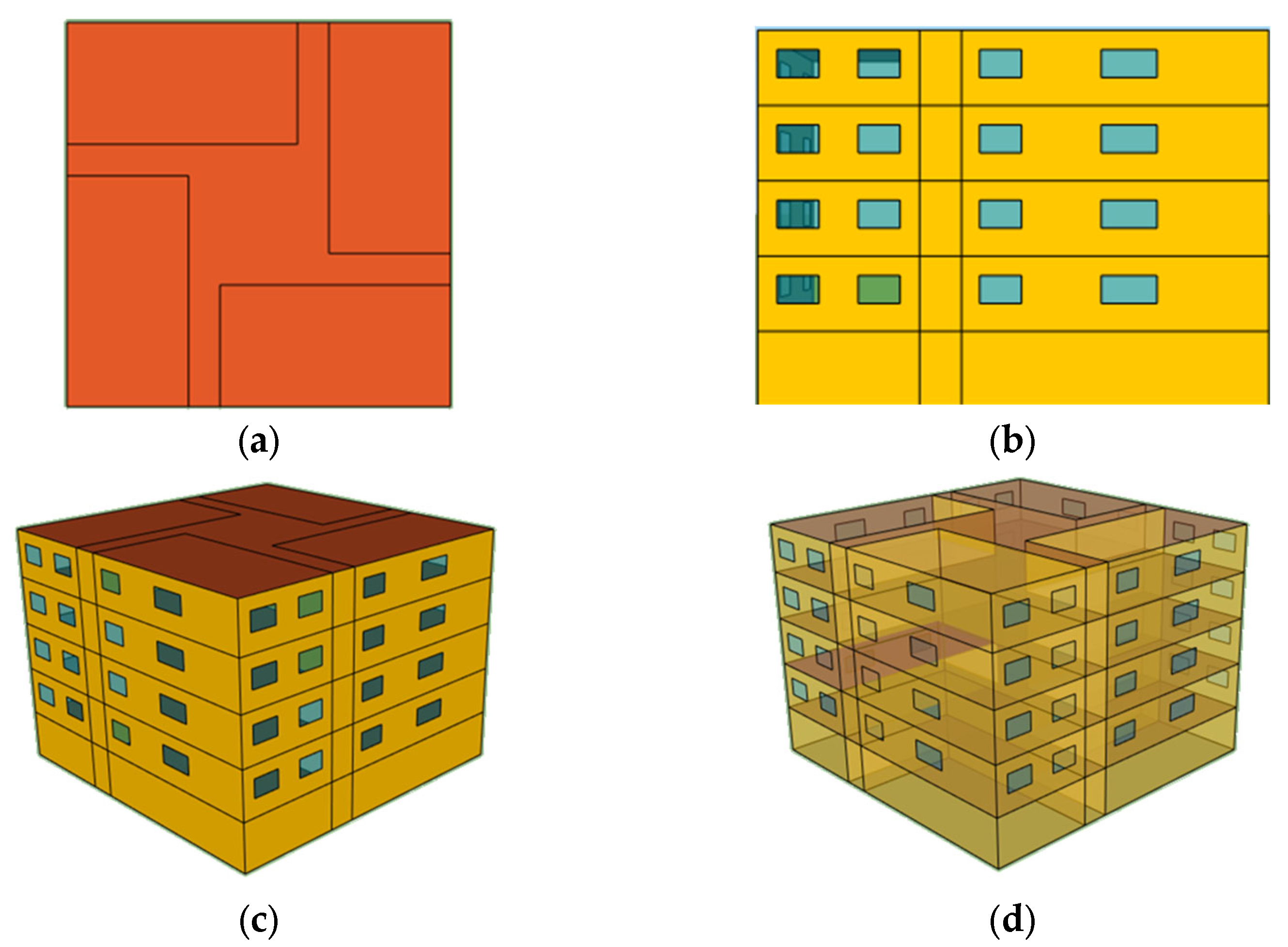

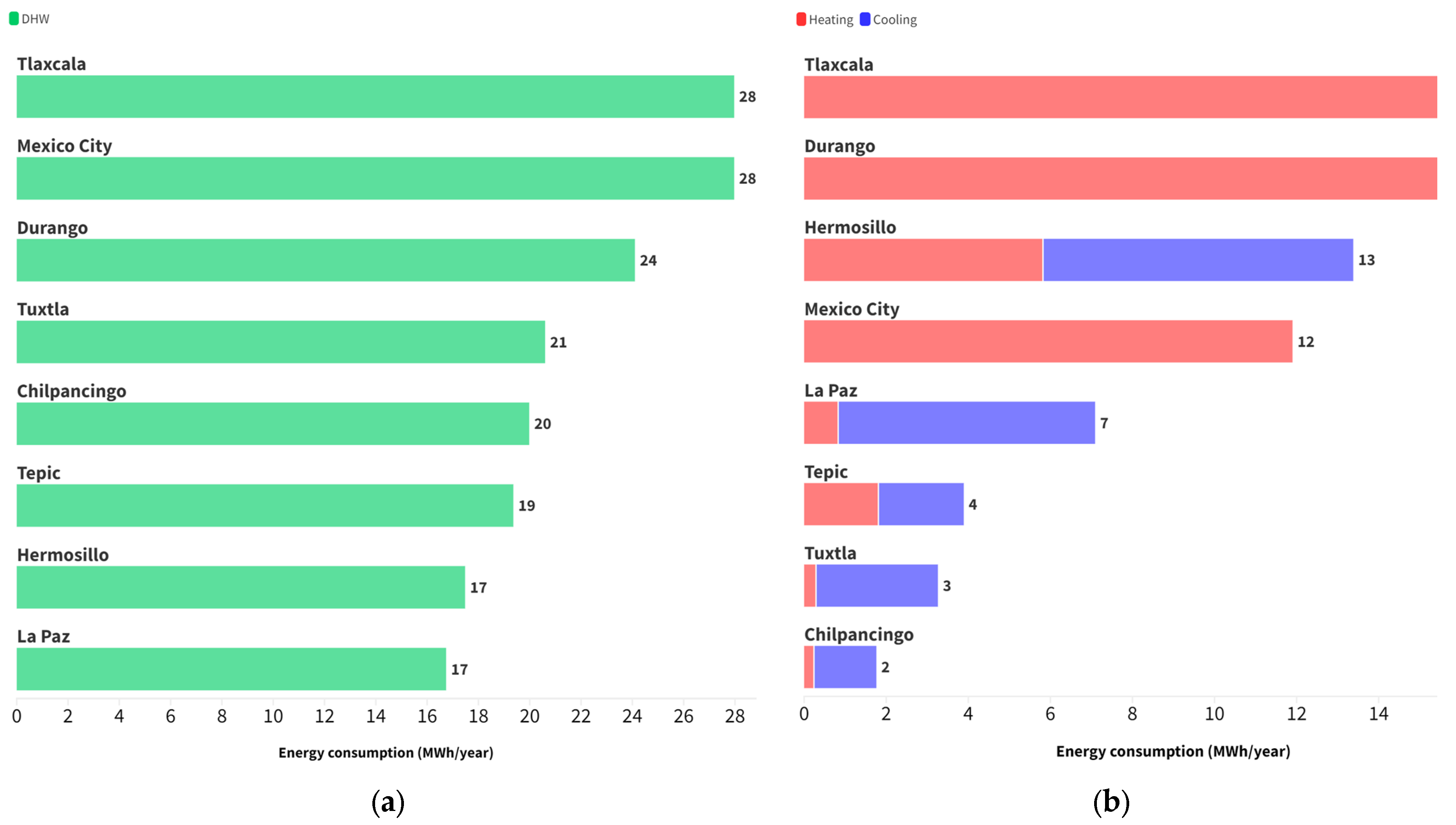

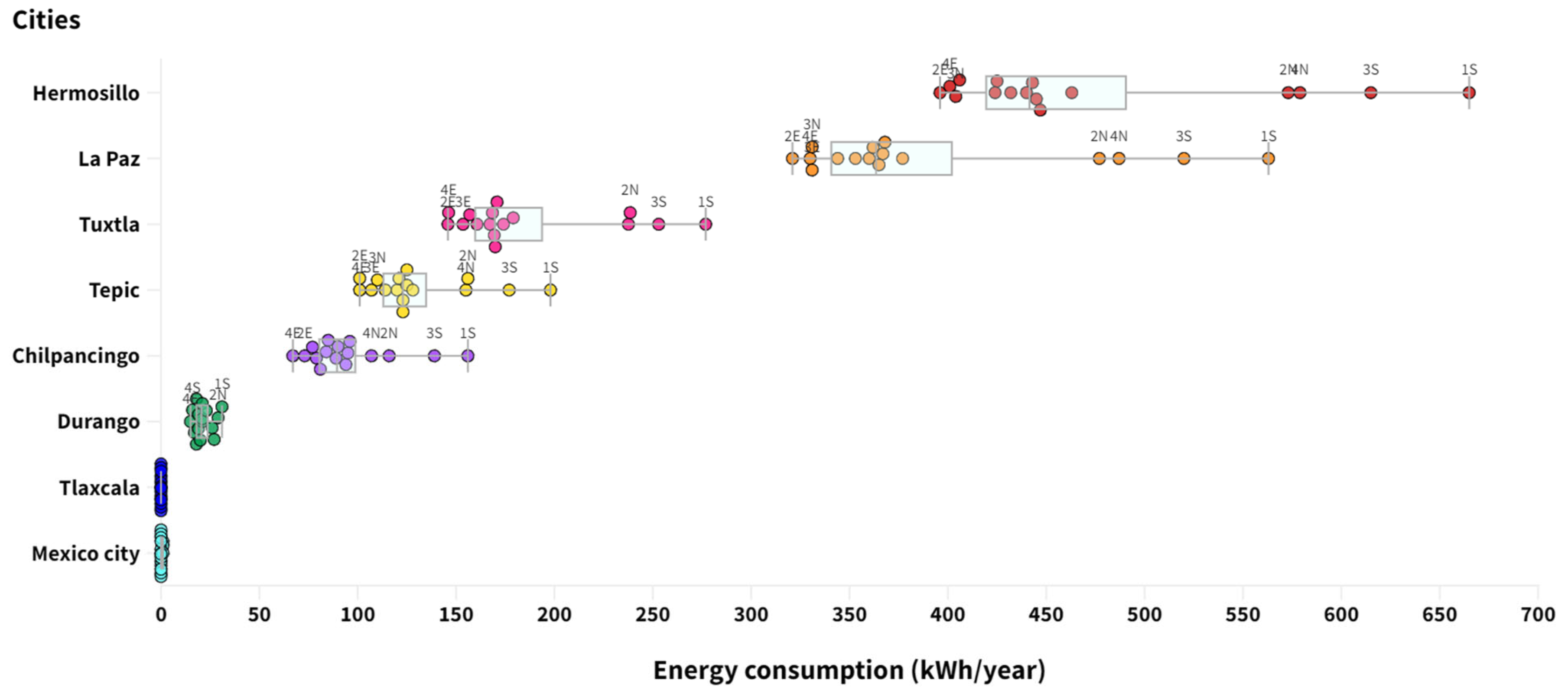
| City | Köppen Climate Classification | Ambient Temperature (°C) | Relative Humidity 1 (%) | Global Horizontal Irradiation 1 (kWh/m2) | Precipitation 1 (mm) | ||
|---|---|---|---|---|---|---|---|
| Annual Average | Minimum | Maximum | |||||
| Chilpancingo | Aw | 23.6 | 14.0 | 34.1 | 48.4 | 2244 | 991 |
| Durango | BSk | 18.6 | 3.6 | 32.7 | 40.8 | 2051 | 651 |
| Hermosillo | BWh | 25.6 | 9.1 | 39.7 | 37.3 | 2036 | 661 |
| La Paz | BWh | 25.7 | 13.5 | 37.2 | 52.8 | 2153 | 210 |
| Mexico City | Cwb | 18.0 | 8.4 | 26.2 | 46.7 | 1826 | 887 |
| Tepic | Csa | 22.6 | 9.9 | 32.8 | 65.8 | 2038 | 2277 |
| Tlaxcala | Cwb | 16.8 | 6.1 | 27.2 | 52.4 | 2033 | 1061 |
| Tuxtla | Aw | 24.3 | 15.4 | 33.3 | 66.4 | 1963 | 2281 |
| Ciudad | Minimum Temperature (°C) | Maximum Temperature (°C) |
|---|---|---|
| Chilpancingo | 21.4 | 28.2 |
| Durango | 21.7 | 28.3 |
| Hermosillo | 21.7 | 28.4 |
| La Paz | 21.3 | 28.1 |
| Mexico City | 21.5 | 28.1 |
| Tepic | 21.2 | 27.5 |
| Tlaxcala | 21.3 | 28.0 |
| Tuxtla | 20.9 | 27.8 |
| Appliance | Frequency of Use (Days/Month) | Average Daily Use (min) | Electrical Power (W) |
|---|---|---|---|
| Blender | 18 | 10 | 550 |
| Coffee maker | 19 | 29 | 900 |
| Hairdryer | 13 | 17 | 1875 |
| Iron | 4 | 65 | 1302 |
| Laptop/PC | 16 | 153 | 32 |
| Microwave | 16 | 15 | 1570 |
| Mixer | 3 | 16 | 200 |
| Modem | 30 | 1384 | 5 |
| Refrigerator | 30 | 1440 | 401 * |
| Television | 28 | 224 | 50 |
| Toaster | 9 | 12 | 800 |
| Washing machine | 4 | 127 | 203 ** |
| Building Component | Exterior Walls | Interior Walls | Roof | Windows |
|---|---|---|---|---|
| Materials | Mortar, concrete block, gypsum plaster | Gypsum plaster, concrete block, gypsum plaster | Cast concrete, lightened slab, stucco | Single-glazed, aluminum frame |
| Thickness (m) | 0.200 | 0.190 | 0.170 | 0.003 |
| U-value (W/m2·K) | 2.312 | 2.279 | 0.530 | 0.855 * |
| W (2 Bedroom) | N (3 Bedroom) | E (2 Bedroom) | S (3 Bedroom) | |
|---|---|---|---|---|
| P1 (first floor) | 2 | 4 | 3 | 5 |
| P2 (second floor) | 3 | 5 | 2 | 4 |
| P3 (third floor) | 2 | 4 | 3 | 5 |
| P4 (fourth floor) | 3 | 5 | 2 | 4 |
| Home | Appliances (kWh/Month) | Lighting (kWh/Month) | Fixed Electricity (kWh/Month) | Cooking (kg/Month) | Fixed LPG (kg/Month) |
|---|---|---|---|---|---|
| Two-bedroom | 76.52 | 30.27 | 106.79 | 11.12 | 11.12 |
| Three-bedroom | 82.95 | 32.37 | 115.32 | 11.12 | 11.12 |
| City | Calorific Energy (MJ/Year) | LPG (kg/Year) |
|---|---|---|
| Chilpancingo | 54,681 | 1488 |
| Durango | 65,959 | 1795 |
| Hermosillo | 47,846 | 1302 |
| La Paz | 45,795 | 1246 |
| Mexico City | 76,554 | 2083 |
| Tepic | 52,972 | 1441 |
| Tlaxcala | 76,554 | 2083 |
| Tuxtla | 56,390 | 1534 |
| Chilpancingo | Durango | Hermosillo | La Paz | Mexico City | Tepic | Tlaxcala | Tuxtla | |
|---|---|---|---|---|---|---|---|---|
| Lighting 1 | 6014 | |||||||
| Appliances 1 | 15,309 | |||||||
| Cooking 2 | 28,669 | |||||||
| Water heating 2 | 19,981 | 24,102 | 17,483 | 16,743 | 27,973 | 19,356 | 27,973 | 20,605 |
| Heating 1 | 241 | 17,072 | 5824 | 835 | 11,901 | 1812 | 17,460 | 287 |
| Cooling 1 | 1527 | 343 | 7559 | 6256 | 5 | 2084 | 1 | 2968 |
| Fixed energy | 49,992 | |||||||
| Variable energy | 21,749 | 41,517 | 30,866 | 23,834 | 39,879 | 23,252 | 45,434 | 23,860 |
| Total | 71,741 | 91,509 | 80,858 | 73,826 | 89,871 | 73,244 | 95,426 | 73,852 |
| Electricity | 23,091 | 38,738 | 34,706 | 28,414 | 33,229 | 25,219 | 38,784 | 24,578 |
| LPG | 48,650 | 52,771 | 46,152 | 45,412 | 56,642 | 48,025 | 56,642 | 49,274 |
| City | Average Bill According to ENCEVI | Estimated Energy Bill for the Average Simulated House | |||||
|---|---|---|---|---|---|---|---|
| Fixed Energy | Fixed Energy and Cooling and Heating | Fixed Energy and Cooling | |||||
| ($MXN) | Average ($MXN) | Differences (%) | Average ($MXN) | Differences (%) | Average ($MXN) | Differences (%) | |
| Chilpancingo | 344 | 230 | 33 | 251 | 27 | 248 | 28 |
| Durango | 253 | 9 | 721 | 185 | 234 | 8 | |
| Hermosillo | 392 | 41 | 392 | 0 | 321 | 18 | |
| La Paz | 375 | 39 | 315 | 16 | 305 | 19 | |
| Mexico | 277 | 17 | 522 | 88 | 229 | 17 | |
| Tepic | 289 | 21 | 277 | 4 | 254 | 12 | |
| Tlaxcala | 208 | 10 | 721 | 247 | 229 | 10 | |
| Tuxtla | 249 | 8 | 269 | 8 | 265 | 6 | |
| Average | 298 | 22 | 434 | 72 | 261 | 15 | |
| City | Reference Building | Gas Duration (Months) in Local Surveyed Homes; Percentage Distribution According to ENCEVI | Accordance Between RB and the Most Frequent Answer in ENCEVI | ||||||
|---|---|---|---|---|---|---|---|---|---|
| Average Home Gas Consumption | Most Common Gas Recharge | Estimated Recharge Duration | |||||||
| (kg/Month) | (Months) | <1 | 1–2 | 2–4 | 4–6 | >6 | |||
| Chilpancingo | 18.9 | Small | 1.1 | 21% | 37% | 32% | 8% | 2% | ✓ |
| Durango | 20.5 | Large | 1.5 | 18% | 33% | 32% | 13% | 4% | ✓ |
| Hermosillo | 17.9 | Large | 1.7 | 9% | 30% | 32% | 19% | 9% | |
| La Paz | 17.6 | Large | 1.7 | 5% | 20% | 37% | 21% | 16% | |
| Mexico City | 22.0 | Small | 0.9 | 41% | 38% | 13% | 6% | 1% | ✓ |
| Tepic | 18.6 | Large | 1.6 | 2% | 18% | 43% | 24% | 13% | |
| Tlaxcala | 22.0 | Small | 0.9 | 46% | 36% | 16% | 2% | 0% | ✓ |
| Tuxtla | 19.1 | Large | 1.6 | 6% | 20% | 43% | 16% | 14% | |
Disclaimer/Publisher’s Note: The statements, opinions and data contained in all publications are solely those of the individual author(s) and contributor(s) and not of MDPI and/or the editor(s). MDPI and/or the editor(s) disclaim responsibility for any injury to people or property resulting from any ideas, methods, instructions or products referred to in the content. |
© 2025 by the authors. Licensee MDPI, Basel, Switzerland. This article is an open access article distributed under the terms and conditions of the Creative Commons Attribution (CC BY) license (https://creativecommons.org/licenses/by/4.0/).
Share and Cite
Espino-Reyes, C.A.; Ortega-Avila, N.; Lucero-Álvarez, J.; Rodríguez-Muñoz, N.A. Energy Consumption in Mexican Homes: Using a Reference Building as a Launchpad for Achieving Nearly Zero Energy. Urban Sci. 2025, 9, 113. https://doi.org/10.3390/urbansci9040113
Espino-Reyes CA, Ortega-Avila N, Lucero-Álvarez J, Rodríguez-Muñoz NA. Energy Consumption in Mexican Homes: Using a Reference Building as a Launchpad for Achieving Nearly Zero Energy. Urban Science. 2025; 9(4):113. https://doi.org/10.3390/urbansci9040113
Chicago/Turabian StyleEspino-Reyes, Carlos A., Naghelli Ortega-Avila, Jorge Lucero-Álvarez, and Norma A. Rodríguez-Muñoz. 2025. "Energy Consumption in Mexican Homes: Using a Reference Building as a Launchpad for Achieving Nearly Zero Energy" Urban Science 9, no. 4: 113. https://doi.org/10.3390/urbansci9040113
APA StyleEspino-Reyes, C. A., Ortega-Avila, N., Lucero-Álvarez, J., & Rodríguez-Muñoz, N. A. (2025). Energy Consumption in Mexican Homes: Using a Reference Building as a Launchpad for Achieving Nearly Zero Energy. Urban Science, 9(4), 113. https://doi.org/10.3390/urbansci9040113






